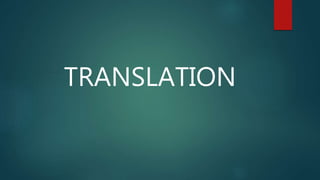
Translation of of mRNA to protein
- 1. TRANSLATION
- 2. INTRODUCTION The biosynthesis of a protein or a polypeptide in the Living cell is referred to as translation. The genetic information stored in DNA is passed on to RNA (through transcription), and ultimately expressed in the language of proteins Erythrocytes (red blood cells) lack the machinery for translation, and therefore cannot synthesize proteins.
- 3. Genetic code The three nucleotide (triplet) base sequences in mRNA that act as code words for amino acids in protein constitute the genetic code or simply codons. The codons are composed of the four nucleotide bases, namely the purines-adenine (A) and guanine (C), and the pyrimidines-cytosine (C) and uracil (U). These four bases produce 64 different combinations (4*3) of three base codons, The nucleotide sequence of the codon on mRNA is written from the 5'-end to 3'end. Sixty one codons code for the 20 amino acids found in protein.
- 4. The three codons UAA, UAG and UGA do not code for amino acids. They act as stop signals in protein synthesis. These three codons are collectively known as termination codons or nonsense codons. The codons UAC, UAA and UGA are often referred to, respectively, as amber, ochre and opal codons.
- 5. Characteristics of genetic codes Universal :The same codons are used to code for the same amino acids in all the living organisms Specificity: : A particular codon always codes for the same amino acid, hence the genetic code is highly specific or unambiguous e.g. UCC is the codon for tryptophan. Non-overlapping: i.e the adjacent codons do not overlap Degenerate :Most of the amino acids have more than one codon. The codon is degenerate or redundant, since there are 61 codons available to code for only 20 amino acids. For instance, glycine has four codons.
- 7. Protein synthesis The protein synthesis which involves the Translation of nucleotide bases sequence of mRNA into the language of amino acid sequence may be divided into the following stages for the Convenience of understanding l. Requirement of the components II. Activation of amino acids lll. Protein synthesis proper lV. Chaperones and protein folding V. Post-translation modifications
- 8. 1.Requirement of the components Amino acids Ribosomes: The functionally active ribosomes are the centres or factories for protein synthesis. Messenger RNA (mRNA) Transfer RNAs (tRNAs) Energy sources : Both ATP and GTP are required for the supply of energy in protein synthesis
- 9. The codon of the mRNA is recognized by the Anticodon of tRNA . They pair with each other in antiparallel direction ( 5' -> 3' of mRNA with 3' -> 5' of tRNA). The usual conventional Complementary base pairing( A = U, C = G) occurs between the first two bases of codon and the last two bases of anticodon. The third base of the codon is rather lenient or flexible with regard to the complementary consists of seven nucleotides and it recognize the three letter codon in mRNA. CODON – ANTICODON RECOGNITION
- 10. 2. Activation of amino acids
- 11. 3.Protein synthesis proper The protein or polypeptide synthesis occurs on the ribosome. The mRNA is read in the 5'->3' direction and the polypeptide synthesis proceeds from N- terminal end to C-terminal end. Translation proper is divided into three stages i.e Initiation , elongation and termination 1. initiation this is further divided into four steps Ribosomal dissociation. Formation of 43S preinitiation complex. Formation of 48S initiation complex. Formation of 80S initiation complex.
- 13. 2. Elongation Ribosomes elongate the polypeptide chain by a sequential addition of amino acids.The amino acid sequence is determined by the order of the codons in the specific mRNA . Elongation , a cyclic process involving certain elongation factors( Efs,) may be divided into three steps. i. Binding of aminoacyl tRNA to A-site. ii. Peptide bond formation. iii. Translocation
- 15. 4.Chaperones and protein folding
- 16. 5.Post-translation modifications The proteins synthesized in translation are, as such, not functional. Many changes take place in the polypeptides after the initiation of their synthesis or, most frequently, after the protein synthesis is completed. These modifications include protein folding , trimming by proteolytic degradation, intein splicing and covalent changes which are collectively known as post-translational modifications.
- 17. Thank you